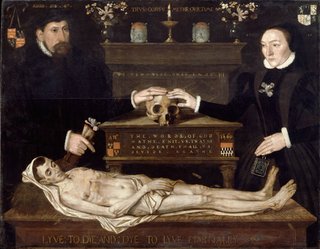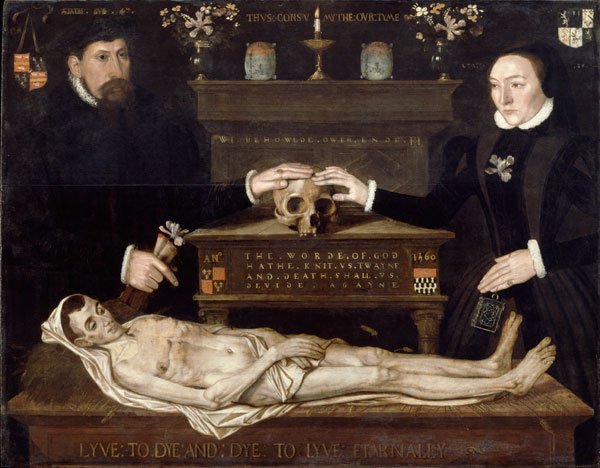-
Acquisition
Cartwright Bequest, 1686
-
Accession number
DPG354
-
Artist
British School
-
Date
c. 1560
-
Dimensions
80 x 102.2 cm
-
Inscription
Inscribed, top: AETATIS SVE 47 and THVS:CONSVMYTHE:OVR:TYME; on the wool sacks beside the candle: GOOD LEMSTER. p. DAELL; upper centre :WE.BEHOWLDE.OWER.ENDE; lower centre: ANo 1560 and THE.WORDE.OF.GOD/ HATHE.KNIT VS.TWAYNE/ AND.DEATH.SHALL.VS./ DIVIDE.AGAYNE; and, at the bottom: LYVE:TO:DYE:AND:DYE TO LYVE ETERNALLY. The original frame is inscribed:WHEN WE ARE DEADE AND IN OWR GRAVES, AND ALL OWRE BONES ARE ROTTUN, BY THIS SHALL WE REMEMBERD BE, WHEN WE SHULDE BE FORGOTTYN.
-
Materials
Oil on oak panel
-
Notes
Adopted by Hilary Rosser, 1996
This double portrait of William Judde (c. 1513–91) and his wife Joan (née Williams; born c. 1532) commemorates the occasion of their marriage. Though the moment is a celebratory one, the setting is somewhat macabre and devoutly sombre, with a skull taking centre stage. In fact, this painting is a striking example of a memento mori, an artistic reminder of the transience of life and the inevitability of death. The maxim written across the painting’s lower edge – ‘Lyve to dye and dye to Lyve eternally’ (‘Live to die and die to live eternally’) – the blossoming flowers, flickering candle and withering corpse, combine to become a meditation on the fleeting nature of earthly existence and the promise of a future in heaven.
The couple can be identified by their coats-of-arms in the top corners of the painting while their initials ‘WJ’ and ‘JJ’ are inscribed in gold lettering on the wooden sideboard or domestic altar above the skull. William Judde was a merchant trading in wool, skins and furs. He and his wife would have been comfortably wealthy, a fact highlighted by their fine clothes and costly accessories.

Want to use or download this artwork?
For personal use - Download artwork
For commercial use - Purchase a licence & download on Bridgeman images
